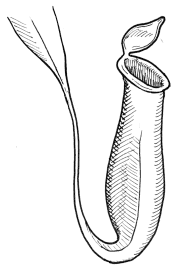Most plants manufacture their own food by the process of
photosynthesis. They get the nutrients they need from the air, water, and soil. However,
some plants have lost some or all of their ability to photosynthesize, and must get
nutrients from other organisms. Plants that draw food from other living organisms are
called parasites; plants that draw food from dead
or decaying organisms are called saprophytes.
We’ll talk more about these plant relationships in Part II of this course.Perhaps the most interesting method for meeting nutritional needs
occurs in the carnivorous plants like sundews and pitcher plants.
Pitcher Plant
pitchers hang from tendril-like extensions of leaf midribs

Carnivorous plants often inhabit places such as swamps and
bogs where available nitrogen is scarce. (Saturated soils are oxygen-deficient, meaning
that the pace of the decomposition of organic matter is extremely slow. It is this
decomposition that yields nitrogen in a form available to plants.) These plants fill some
of their nitrogen requirements by trapping insects, then using enzymes to
"digest" the bodies of their prey. Though stories of "man-eating"
carnivorous plants arise from time to time, the most common prey are insects, mites, and
sometimes very small frogs. There are reports of carnivorous pitcher plants large enough
to capture and digest small frogs and mice, but no man-eating specimens have been
documented....Yet!
Of course these adaptations for fulfilling basic needs are
in vain if the plant is munched by a passing herbivore! So plants also evolved various
means of protecting themselves.
|
|
|
|
|